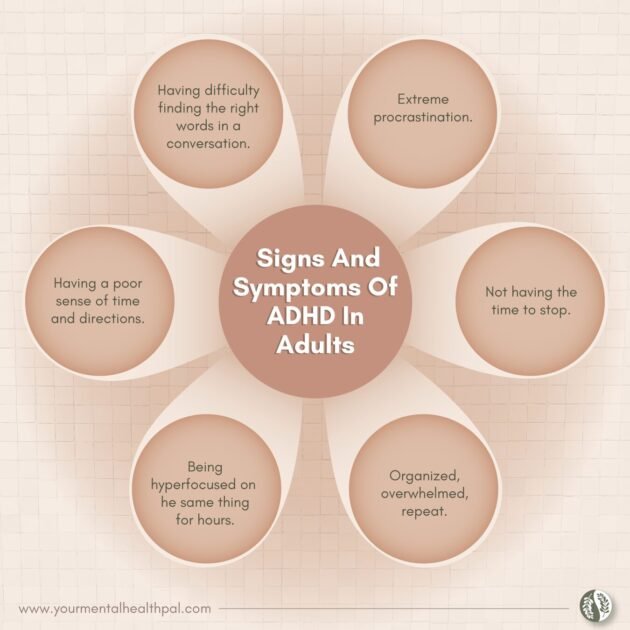Throughout the 200-year-old history of attention-deficit/hyperactivity disorder, it has been thought of as a children’s condition. Initially, it was associated with fidgety and trouble-making high-school boys who often went to the medical room at lunchtime to get medicines. It was believed that these kids would eventually grow out of the condition.
As medical research into the topic expanded, so did the understanding of the world about what ADHD was. But it was only in the late 1990s that scientists realized that ADHD in adults was real. It was during this time when credible proof showed up that people who had symptoms of ADHD as children could continue to experience them throughout their adulthood.
So, is adult ADHD a missed diagnosis as a child, or can it also develop in adulthood?
Well, the jury is still out on that.
With that said, in the past three decades, adult ADHD has gone from a barely recognized condition to something that affects 365 million people globally. This number translates to around 10 million people from the US alone.
While the stereotypical description of ADHD paints it as fidgety and impulsive humans, it’s a lot more complicated and different in adults. The signs of ADHD in adults can be confusing for people who are diagnosed in the later part of their life because their symptoms might be entirely unrelated to focus or attention.
To help you get started on what ADHD in adults actually looks like, we will dive into the signs and symptoms of the condition, its diagnosis, and available treatment options.

But before we get started, here’s something important.
Mental and neurological health are diverse and complex. They exist on a spectrum, and every individual has their own experiences. Therefore, don’t start diagnosing yourself with the knowledge you get by reading a few articles on the Internet (though we are incredibly grateful to you for stopping by to enhance your understanding of an important topic). If you find this article helpful or resonate with the symptoms explained in it, consider this as the beginning of your journey of getting the right help.
That’s it. Let’s dive in!

Signs And Symptoms Of ADHD In Adults
1. Having difficulty finding the right words in a conversation.
One of the most common signs of ADHD in adults is not being able to keep up with an argument or conversation after a point. They find it challenging to convey their perspective properly. ADHD in adults makes it hard to be expressive. Therefore, if you struggle to narrate a story properly because you can’t coherently project your thoughts, it might be one of the warning signs of ADHD.
This generally happens because of the inherent disconnect between the internal and external minds of those with ADHD. Simply put, a person with ADHD might be in a completely different space in their head than their words.
However, this is not the case with the initial part of the conversation. The initiation of the conversation is when brains with adult ADHD would be synced. However, this is a struggle for those engaging in heated debates or extended conversations requiring verbal clarity.
2. Extreme procrastination.
Another common adult ADHD symptom is being extremely avoidant of your work.
You see, brains with adult ADHD are on the constant lookout for activities that give them a boost of dopamine (the feel-good hormone). Since routine tasks don’t provide enough sustained dopamine, adults with ADHD might not find them as interesting. This way, they might try to find all possible ways to avoid doing them.
Now, you might think every second person feels bored and zoned out during routine work. How is it one of the hidden signs of ADHD in adults?
The devil hides in the details! So, even though an average person feels zoned out during routine tasks, for adults with ADHD, this feeling is extreme, and so is the avoidance they use to deal with it. In fact, this is one of the most hidden signs of adult ADHD because it’s most commonly referred to as laziness or a lack of motivation.
3. Not having the time to stop.
Children with ADHD are usually hyperactive and fidgety. However, symptoms of ADHD in adults look a bit different than that.
So, rather than jumping off shelves or being hyperactive, adults feel a sense of restlessness. They might find it extremely difficult to relax and unwind. Their minds are constantly on, and they have an urge to do something all the time. It might be fueled by an overwhelming desire to be productive constantly.
And mind you, this is not just for work days; these tendencies also extend into their holidays.
4. Organized, overwhelmed, repeat.
While ADHD is usually attached to disorganization, it manifests differently in adults. So, rather than being disorganized, one of the most common signs of ADHD in adults is being highly organized. This is mostly done to compensate for their ADHD symptoms.
However, every once in a while, adults with ADHD have a period where they feel extremely overwhelmed and struggle to get anything done. This period can last several days and might result from the extra effects people have to put in to be organized while having ADHD.
5. Hyperfocused on the same thing for hours.
Having adult ADHD means finding it extremely hard to start new things, especially ones you find daunting or difficult. However, once you get started, you become so hyperfocused on the task at hand that any other commitments you have might suffer.
Hyperfocus is one of the adult ADHD symptoms that easily gets missed because people feel they are motivated to complete a certain task.
Difficulty in switching between tasks or gears is usually a result of the dopamine levels in the brain. Being hyperfocused gives a greater dopamine boost and keeps the person engaged for longer durations.
6. Having a poor sense of time and directions.
Adults with ADHD are often late because of their poor sense of time. This means they constantly underestimate or overestimate the amount of time something can take.
Additionally, another one of the warning signs of ADHD in adults is not being able to distinguish between left and right directions.
What Causes Adult ADHD?
Doctors are still unsure about what actually causes ADHD in adults. However, multiple factors are believed to play a significant role. These include the following:
- genetics,
- poor nutrition in the womb,
- premature birth,
- traumatic brain injury,
- exposure to harmful substances like alcohol, drugs in the womb, etc.
How Is ADHD In Adults Diagnosed?
While it might feel that getting an adult ADHD diagnosis means having lost a critical time for recovery, that’s not the case. Getting an ADHD diagnosis in adulthood is more common than you think, especially for women.
Therefore, if you think you have adult ADHD, it’s essential to consult with your healthcare provider. They can refer you to a psychiatrist who can conduct a full psychiatric assessment of your symptoms. This evaluation would also include someone close to you to rate their observations of your adult ADHD symptoms.
Since a lot of other mental and physical health issues can manifest in similar ways, your doctor might also suggest getting a complete health checkup along with blood tests to rule out other conditions.
As per the mental health guidelines, a few criteria can be considered while diagnosing ADHD in people aged 18 or above. These include the following:
- having five or more inattentive or hyperactive symptoms,
- having symptoms in two different settings (like home and work),
- having symptoms that significantly disrupt a person’s life, and
- symptoms rated higher than three on a scale of one to five.
What Are The Best ADHD Treatment For Adults?
While there is no cure for ADHD in adults, several resources might help you deal with your symptoms effectively and improve the quality of your life. These include medications, behavioral therapy, and lifestyle changes.
In the case of medications, your healthcare provider might prescribe you the required drugs as per your treatment plan. These might include stimulants (dopamine-increasing drugs) used to treat ADHD in children.
In addition to medications, behavioral therapy is another highly effective treatment for adult ADHD. It helps identify the adverse actions that arise as a result of your ADHD symptoms and provides you with useful ways to manage them.
Apart from behavioral therapy, support groups for adults with ADHD can also help you understand more about what you are dealing with.
Conclusion:
Having ADHD as an adult can be extremely daunting and tough. It might force you to relook at your entire life. This is why knowing and understanding more about what you are dealing with will help. We hope this post on ADHD in adults will be a useful starting point for you.
If reading this blog post made you feel like you might have adult ADHD, take a deep breath and calm down. As scary as it feels right now, just remember that millions of people around you struggle with the disorder and get better every day. While the road is complicated and long, proper professional help and self-care are the right way forward.
Access to professional help is now easier than ever. With online therapy, you can experience the comfort of therapy right from your home. To learn more about the top online platforms, click here.
To continue learning about mental health, subscribe to Your Mental Health Pal.

